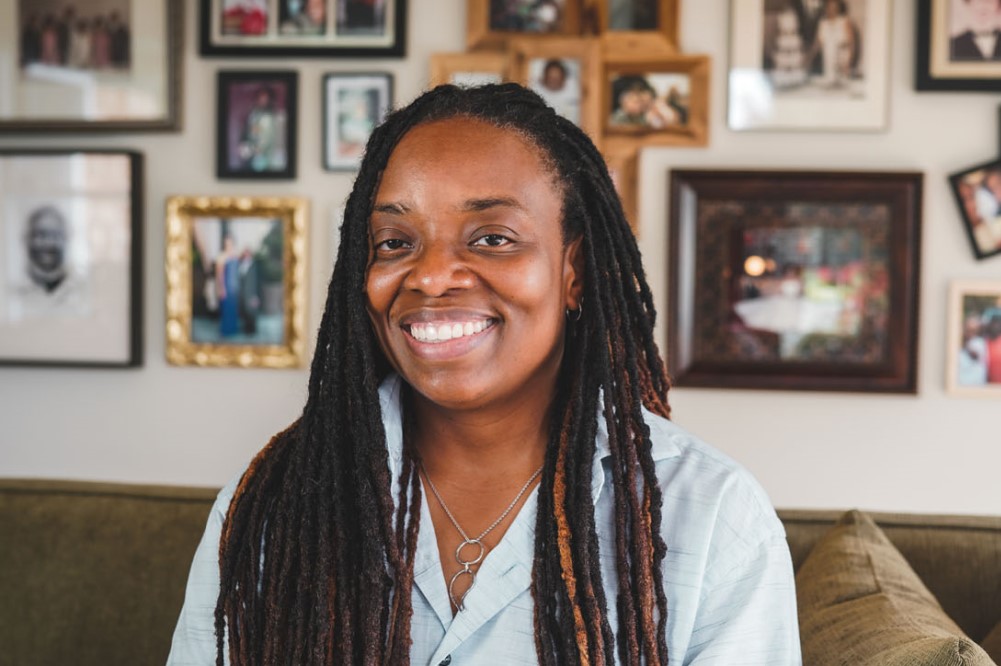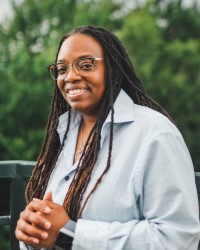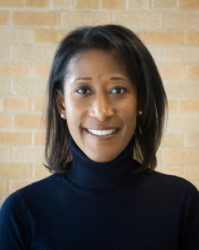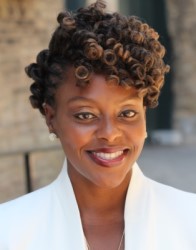
As cities and counties continue to grow in variations of age, economic status, educational attainment, immigration levels, and population size, they find themselves in need of someone who can focus on identifying disparities in community programs and services and on helping create ways for departments to address those gaps.
This is especially important now, as COVID-19 has exacerbated our communities’ racial and class disparities, while we also experience global civil unrest over racial and social injustice.
Enter the chief equity officer. No matter the exact job title, they will be crucial in leading the charge for equity and inclusivity.
Learn how these five leaders have established an equity and inclusion presence in their local government, along with their challenges, successes, and their advice for local governments trying to create an equitable and inclusive environment.
 Tyeastia Green | Director of Racial Equity, Inclusion, and Belonging | Burlington, Vermont
Tyeastia Green | Director of Racial Equity, Inclusion, and Belonging | Burlington, Vermont

Tell us about your role.
My long-term focus is on changing and challenging practices and policies that harm BIPOC (Black, Indigenous, and People of Color). Currently, my focus is on ensuring a racially just recovery from the COVID-19 pandemic, as well as the racial reckoning happening across the country. It is important to me that I fully utilize this role to ensure that Burlington will be on the right side of history moving forward. »
What is one of the biggest challenges your community is facing right now and how does it intersect with systemic racism?
It is important to frame racism as what it is—a system, not an event. I believe the challenges of racism in all forms affect each community the same—regardless of whether you live in the north or south, or on either of the coasts or the heartland, racism in its structural, institutional, and systemic form doesn’t change. Because racism is systemic, and the basis of all things we hold dear as Americans, we would be hard pressed to find an avenue where systemic racism isn’t. Racism is in education, healthcare, income, wealth attainment, housing, childcare, banking, and on and on. It’s everywhere, making it extremely pervasive. It’s what we eat, drink, and breathe. It’s normalized. When I think of the challenge of undoing systemic racism, I have the image of a ball of rubber bands. Once you think you’ve got the hang of unraveling it, you realize there’s so much going on underneath, and some of the rubber bands feel impossible to remove.
What have you found to be the best method for speaking up in a non-diverse room? How do you engage with people reluctant, afraid, or uncomfortable with having these discussions?
I’ve always believed the best method to speak up in any room is with honesty. No smoke and mirrors, just pure honesty. An important aspect of inclusion and belonging is to be able to show up as who you are—authentic, with your life story and the way you see the world. Affinity groups are a great option for having these discussions with people who see the world as you do. They provide the safe space that people need to really dig deep in these conversations. When you’re in a safe space, it removes the requirement to be brave. During affinity group meetings, racial awakening occurs. It is when whites realize that they too have a race, have been racialized, and that their race has meaning. For BIPOC communities, affinity groups can provide guidance on how to navigate white spaces, how to share methods of resiliency, but also how to work toward accomplishing self-care. It is not the oppressed communities who should be tasked with fixing racism. That work falls solely on those who are a part of the dominant group. Racial awakening is an important step of that work and at the core of dismantling systemic racism.
What advice do you have for small local governments trying to create an equitable and inclusive environment?
My advice would be to focus on race-centered policies. There’s too much focus on race-neutral policies because that’s what is deemed to be politically correct. I believe one of the biggest barriers we have to becoming inclusive is steeped in political correctness. The way that I’m defining political correctness means to not upset the status quo, and not disrupt normalcy. We have to remove the standard of normalcy in order to be equitable and inclusive. What is normal for me may not be normal for you. We should insist on the celebration of culture; celebrate the uniqueness and the gifts that we receive from being inclusive. The standard of our society is to center whiteness, which is the standard of normalcy, and how we define normal. When we use terms like diversity, a question you should ask yourself is, diverse from what? And the answer that will appear is different from whiteness. The term diversity keeps white supremacy culture alive by “othering” populations who are not white. Don’t ask, “how do I attract diverse talent?” or “how can I increase diversity in my organization?” Instead, ask what it means to be inclusive of other races, cultures, and perspectives. It is not about seeking answers externally. It’s about looking inward by performing organizational analysis, and receiving the answers to make significant changes.
How do you get your leadership engaged in supporting your efforts?
Every day I come to work as my authentic self. It is my job to point out instances when whiteness is centered; it is also my job to keep BIPOC in the forefront of our minds when we are making decisions that will undoubtedly affect them and all too often leave them out. I am here to ensure that BIPOC aren’t left out. I am here to ensure that the city works toward achieving racial equity. Showing up as who you are gives you the confidence and the fearlessness needed to engage with leadership. Early on in my tenure I engaged the mayor on declaring racism a public health emergency. We were able to do that together with the help of the Vermont Racial Justice Alliance and many organizations throughout the city in July. I believe that the elected body in Burlington is extremely engaged in supporting racial justice. In June, the city council passed the resolution “Racial Justice through Economic and Criminal Justice” with bipartisan support. The resolution was brought forth to the council by the first black councilwoman for Burlington, Zoraya Hightower. It was historic and groundbreaking, and I believe it makes my job of marching us toward racial justice much easier. With the passing of the FY21 budget, the mayor of Burlington, Miro Weinberger, dedicated $1 million to the fight against systemic racism.
What kind of partners are you finding in the community to help your local government achieve your goals?
We have 30 organizations in the Burlington area (and counting) who have signed on the declaration of racism being a public health emergency. They have also pledged actionable steps toward how they will combat systemic racism within their organizations. This work cannot be done in a bubble. We need all sectors—public, private, and nonprofit—to take the pledge and do the work of undoing America’s longest standing pandemic—racism.
Stefanie A. Bowers |Equity Director and Human Rights Coordinator | Iowa City, Iowa


Tell us about your role.
As the equity director for the city, I work with the city manager’s office on diversity, equity, and inclusion. Specifically, focusing on providing strategies, planning, facilitation, and development of government work on equity and engagement for the present and long term. I also work with city departments to promote and measure equity and inclusion within city operations, and provide and coordinate community education and outreach. Since 2017, I have been training city departments on using a racial equity toolkit/lens to review their policies, services, and programs.
I also publish an annual report on racial equity that measures the city’s progress on increasing the racial diversity of city staff and those serving on city boards and commissions. The report also provides the number of police traffic stops and charges by race of the person.
I also staff the Human Rights Commission (HRC), which consists of nine members of the Iowa City community who serve as an advisory board to the city council, enforce the local anti-discrimination laws, and determine the merits of complaints alleging discrimination that are filed with the office in the areas of employment, housing, education, credit, and public accommodations.
As the LGBTQ liaison for the city executive’s office, I serve as a resource to the city’s LGBTQ communities to access city services and promote equality.
When talking about equity in local government, what does success look like?
Success is not just breaking down and removing the current barriers to equality, but also working to make sure those barriers continue to be eliminated while advancing fair treatment, opportunity, and full participation by all community members.
How do you use data to influence positive outcomes for equity?
The use of racial equity toolkits (RETs) have been very helpful to us in analyzing data we already have or to begin to collect data in a particular area to better inform our decisions. They assist in identifying who benefits and who is burdened by a particular proposal, policy, service, or program. Specifically, RETs have afforded us the opportunity to work with and get feedback from those community members most affected and work with them directly to come up with solutions that either mitigate the barrier or remove it all together. Data and community feedback and engagement also hold us accountable to continually work at improving outcomes for Iowa City residents.
To date, RETs have led to the elimination of late fees for books in the children’s and teen collections at the library, an improved process for how employment opportunities are advertised and promoted to the community, translations of core city documents in languages other than English, an increased number of participants in the Low-Income Utility Discount Program, and a requirement of a BIPOC impact statement as part of the Grants Management Policy.
Toni D. Newborn, JD |Chief Equity Officer | Saint Paul, Minnesota


Tell us about your role.
I lead the equity steering committee, equity design team, and department equity change teams to provide support and guidance in integrating equity into the city’s services, engagement, policies, and practices. I work in partnership with departments to develop educational opportunities for city staff and residents to advance city-wide equity initiatives with the goal of eliminating disparities.
How do you see your role or department expanding within the next two years?
Ideally, my job is to work myself out of a job by working to eliminate disparities and inequities in our city. I will equip our city departments with the resources to view their work through an equity lens. I will provide learning opportunities to staff about anti-racism and anti-blackness. I will work with the mayor and deputy mayor to embed this work into the city enterprise by hiring additional staff to focus on community engagement, inclusive communications, and training and development.
What advice do you have for small local governments trying to create an equitable and inclusive environment?
In order to create an equitable and inclusive work environment, it is important to start with your elected and executive leadership team—mayors, city councilmembers, directors, and city coordinators. The elected need to be your biggest cheerleader. They should be on the front line talking about the importance of equity, diversity, and inclusion.
Karla Bruce |Chief Equity Officer | Fairfax County, Virginia


Tell us about your role.
I was appointed chief equity officer in June 2018, following the adoption in November 2017 of One Fairfax, a policy that commits the Fairfax County Board of Supervisors and School Board to intentionally consider racial and social equity when making policies or delivering programs and services. The policy was enacted after nearly a decade of work to address the disproportionate representation of African American and Latino children in various county and school systems. The policy was an acknowledgment that there was no one root cause and that no single agency or department that could address the problem of disproportionality. The county and school leadership began to understand that efforts focused solely on individual-level factors would not suffice—institutional and structural change was necessary.
Bryan Hill, the county executive of Fairfax County, established the role of chief equity officer, and embedded it in the county executive’s office, to develop and manage a county-wide strategic framework for advancing racial and social equity in Fairfax County. Responsibilities of the role include building the capacity of the workforce and leadership around key equity concepts and advising and supporting the board of supervisors and senior leadership in shaping and directing policy and practice that fosters equitable opportunity for all residents. As chief equity officer, I also work very closely with the community—residents, community-based organizations, and philanthropy—to gain a deeper understanding of how the doors of opportunity have been opened or closed to different populations and areas of the county and to co-create solutions that will advance the county’s progress toward equity.
What is one of the biggest challenges your community is facing right now and how does it intersect with systemic racism?
Like most jurisdictions, addressing the compounding and intersecting issues associated with the coronavirus is the biggest challenge facing our community. While COVID-19 is a public health crisis, Fairfax County is confronting it recognizing that health is tied to the conditions that people live in and the opportunities they have for housing, jobs, transportation, education, healthcare, etc. The way that the pandemic is affecting our community reflects dynamics of race and class that existed well before COVID-19 emerged and that has implications that extend beyond health.
Fairfax County is approaching COVID-19 from the fundamental position that to effectively respond and recover—from a public health perspective as well as economically—we must understand that our community is only as healthy and strong as those most vulnerable. While we are continuing to implement the critical public health mitigation strategies necessary to curb the spread of the virus and “box it in,” we are also working aggressively to ensure that opportunities are available to all communities so that residents are better prepared to weather the range of challenges that this pandemic has brought, focusing on those experiencing the most adverse health, economic, and social effects.
How do you use data to influence positive outcomes for equity?
First and foremost, data was instrumental in establishing that disparities and inequities exist in Fairfax County, and specifically disaggregated data. Besides the insights we have been able to glean from the analysis of our own programmatic and service data, we have benefited from outside reports from the Northern Virginia Health Foundation and Virginia Commonwealth University and PolicyLink, and the USC Equity Research Institute.
The use of data and analytical tools is giving us a better understanding of the dynamics of opportunity within the county. We are mapping opportunity and vulnerability and examining the structural drivers of disparities to understand who has access to opportunity and who does not. Through policy and practice we can target interventions and resources by geography and population.
What have you found to be the best method for speaking up in a non-diverse room? How do you engage with people reluctant, afraid, or uncomfortable with having these discussions?
The Government Alliance on Race and Equity has great resources for helping people to talk constructively about race. Depending on the context and who I’m talking to, I try to direct the focus away from what people assume has to be the focus of conversations about race—individual acts of bias, bigotry, and discrimination—to help people understand that equity is deeper than changing people. It is about changing the conditions in which people live and improving access to opportunities. One of the challenges that we encounter is that many people come from a deficit model, meaning that they are conditioned to assume that there’s a flaw in people, and that by directing their efforts to correcting the flaw, they will resolve the issues people face. Our premise is that it is not a deficiency in people that produces disparate outcomes. Our efforts must be focused on the systemic and structural nature of racialized outcomes.
Liz Cedillo-Pereira | Chief of Equity and Inclusion | Dallas, Texas


Tell us about your role.
As the chief of equity and inclusion, I provide executive leadership oversight for the offices of Equity, Environmental Quality and Sustainability, Ethics and Compliance, Fair Housing and Human Rights, Resilience, and Welcoming Communities and Immigrant Affairs. This umbrella of offices strives to build and deliver equitable and inclusive programming that serve all Dallas residents.
When talking about equity in local government, what does success look like?
As a city we are striving to embed equity-oriented practices in all that we do, from the budget to structural changes to service delivery. The work of equity is about building an ethos in our organization which recognizes that race and ethnicity continue to predict outcomes for our residents. It is through this recognition that we can identify the need to assess government policies, practices, and programs that reduce disparities among Communities of Color while improving outcomes for all. The work is also about bridging the relationships with Communities of Color and low-income neighborhoods so that all of us can do the tough work together through collaborative and shared decision-making among departments and communities.
What is one of the biggest challenges your community is facing right now and how does it intersect with systemic racism?
One of the biggest challenges for the city of Dallas is enduring the impact of COVID-19. COVID-19 is not like anything we have experienced before as it impacts everyone in various ways—workers, employers, elders, students, all income bands. Yet, we know COVID-19 is disproportionately impacting Communities of Color. We are working to address the root causes of the disproportionality by understanding the underlying determinants of health in Dallas. Communities of Color are frontline or essential workers, they tend to live in multi-generational households and denser environments, they had less access to healthcare pre-COVID, and many neighborhoods have fewer healthy food options. In this moment, the disparities we have been studying have become more evident than ever before. We must ensure that equity is embedded in every step we take to undo systemic barriers so that beyond the pandemic we can truly become a more resilient and inclusive community.
How do you use data to influence positive outcomes for equity?
Data is one of our greatest assets. It serves as a fundamental source to support city departments in thinking about the ways that they can be more equity-oriented when planning and prioritizing for their area of service. In October 2019, the city of Dallas released our Equity Indicators Report, a tool to help Dallas measure disparities and advance equity in our community. The indicators are designed to measure disparities in outcomes across five thematic areas: economic opportunity, education, neighborhoods and infrastructure, justice and government, and public health. This report is highly referred to and used internally within city of Dallas departments, as well as externally in the community.
Derived from an ICMA blog post, “Is It Time to Hire a Chief Equity Officer?”.
New, Reduced Membership Dues
A new, reduced dues rate is available for CAOs/ACAOs, along with additional discounts for those in smaller communities, has been implemented. Learn more and be sure to join or renew today!
